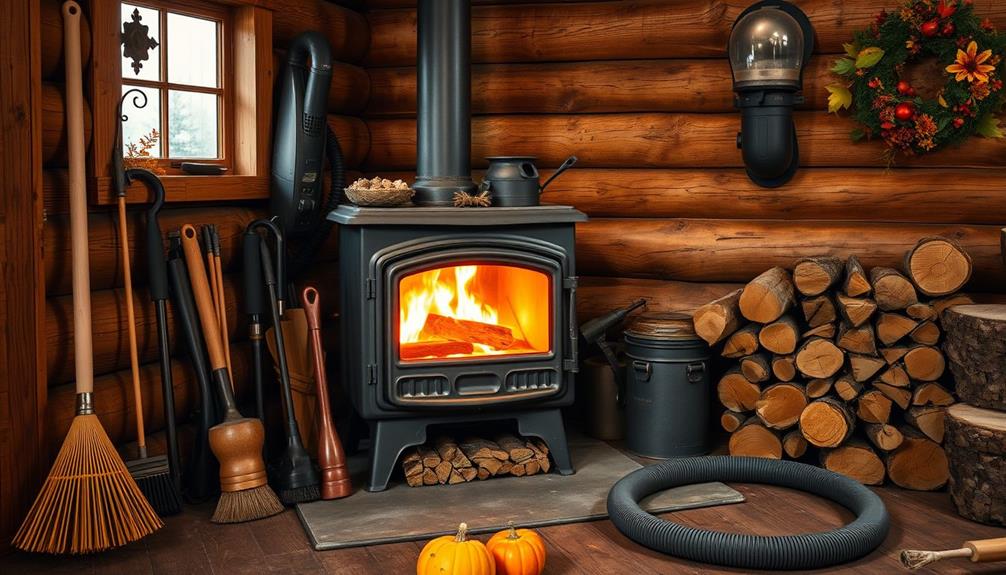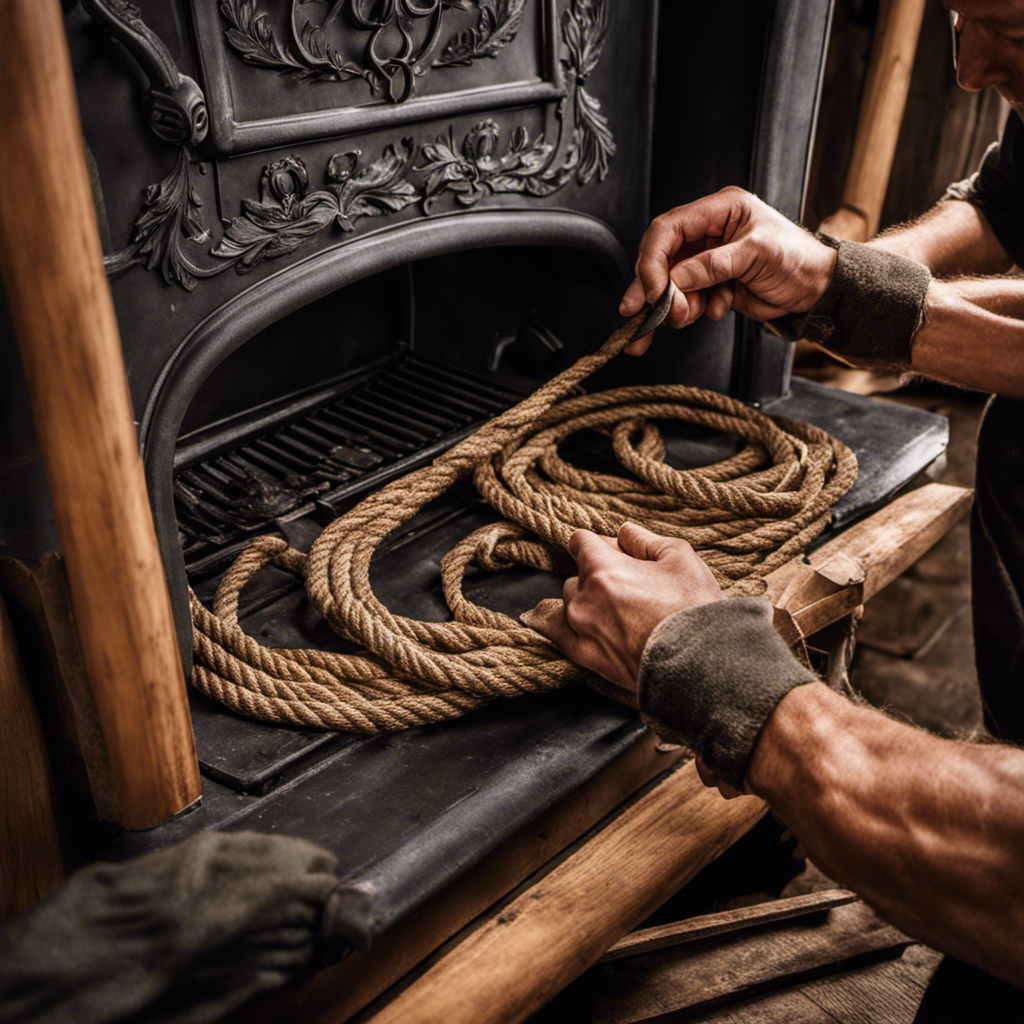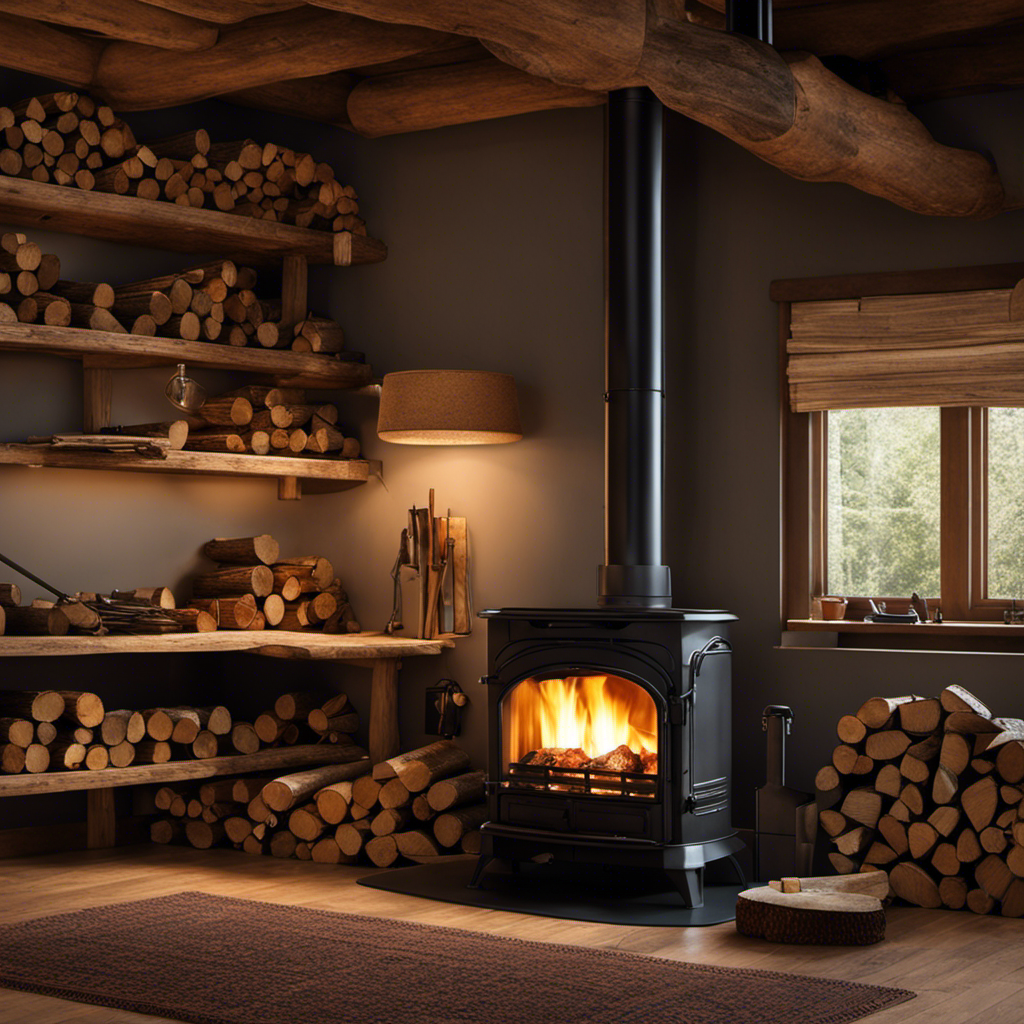To keep your wood stove running efficiently, establish a solid maintenance schedule. Monthly tasks include inspecting the baffle and checking for any wood usage trends. Seasonal maintenance, like cleaning the chimney and checking smoke detectors, is essential for safety. On an annual basis, hire a certified chimney sweep and conduct a thorough inspection of the flue and stove components. Don't forget to regularly remove ashes to guarantee proper airflow. By focusing on these tasks, you'll enhance performance and extend the stove's lifespan. There's plenty more valuable information that can help you optimize your wood stove experience.
Key Takeaways
- Conduct monthly inspections of the baffle and blanket to ensure proper positioning and efficiency in heat distribution.
- Remove ashes weekly to maintain unobstructed airflow and promote efficient combustion in the wood stove.
- Hire a certified chimney sweep annually for thorough inspections and cleaning to prevent creosote buildup and fire hazards.
- Check the stove door gasket regularly using the dollar bill test to ensure an airtight seal and optimal performance.
- Document all maintenance activities and wood usage for tracking stove condition and identifying trends in efficiency and performance.
Importance of Wood Stove Maintenance
Regular wood stove maintenance is vital for guaranteeing your stove operates efficiently and safely. By keeping up with maintenance tasks, you enhance how your wood stove performs, ensuring ideal and efficient heating.
One important aspect is managing creosote buildup, which can pose significant safety hazards if left unchecked. Regular chimney cleaning helps mitigate this risk and keeps your stove in good condition. Additionally, understanding the basics of thermal energy transfer can improve your heating efficiency, assuring you get the most out of your wood stove's performance. Incorporating heat pump technology advancements into your heating strategy may also enhance efficiency and comfort in your home.
Incorporating wood stove maintenance tips into your routine can dramatically extend the longevity of your appliance, potentially adding up to 20 years to its lifespan. Monthly inspections of components like the baffle and blanket can prevent damage and maintain proper combustion efficiency. These simple checks can save you from costly repairs later.
Moreover, scheduling annual inspections with professional chimney sweeps is vital. They can identify blockages or structural issues that may lead to dangerous situations like chimney fires.
Weekly Maintenance Tasks

Every week, you should remove ashes from your wood stove to keep it running efficiently and to promote proper airflow.
It's also a good idea to check for any signs of blockage in the flue, as this can affect performance and safety; clogging remedies can be beneficial if issues arise.
Don't forget to check the stove door gasket for a tight seal; a simple dollar bill test can help you determine if it needs replacing.
Keeping up with these tasks guarantees your stove operates safely and effectively.
Ash Removal Importance
Maintaining your wood stove's efficiency hinges on the regular removal of ashes. Weekly removal is vital for ensuring efficient combustion and ideal heat output. When ash accumulates, it can block airflow, reducing the stove's performance and increasing fuel consumption. More importantly, leftover ash can pose a fire hazard if not managed properly.
| Benefit of Ash Removal | Consequence of Neglect | Safety Tip |
|---|---|---|
| Enhances airflow for efficient combustion | Reduced heat output and increased fuel use | Always use a fire-retardant container for disposal |
| Prevents fire hazards from ash buildup | Risk of ignition and stove malfunction | Let ashes cool completely before handling |
| Maintains a clean operating environment | Increased maintenance costs | Store ashes away from flammable materials |
To keep your home safe and your wood stove running efficiently, you should remove ashes at least once a week during the heating season. Proper disposal in a fire-retardant container is essential to prevent accidental fires. By prioritizing ash removal, you enhance your stove's performance, ensuring you enjoy warm and cozy fires without worry.
Gasket Integrity Check
Ensuring your wood stove's efficiency involves a thorough check of the gasket integrity each week.
A well-maintained gasket provides an airtight seal, essential for peak performance and safety. If you let wear go unchecked, it can lead to air leaks, compromising combustion efficiency and increasing hazardous emissions.
Regular maintenance is key for your home heating system, similar to how garage door openers enhance home security with modern technology.
Follow these steps for an extensive gasket integrity check:
- Dollar Bill Test: Place a dollar bill in the stove door. If it slips out easily, your gasket may need replacement to maintain efficiency.
- Visual Inspection: Look for signs of wear, such as cracks or brittleness. These issues can greatly impact your stove's performance.
- Regular Maintenance: Make it a habit to check the gasket weekly. This practice helps maintain a consistent burn and enhances the overall heating effectiveness of your wood stove.
Monthly Maintenance Tasks

Inspect your wood stove monthly to keep it running efficiently and safely. Start by checking the baffle and blanket. Verify the baffle is properly positioned and free from cracks, as any damage can affect both heating performance and efficiency. Handle the baffle blanket carefully during inspections to avoid damage, as it's essential for ideal stove function.
Make sure the baffle remains flat; misalignment can lead to improper airflow, reducing your stove's heating capabilities. While inspecting, wear gloves to protect your hands from sharp edges or cracked components.
It's also important to maintain records of your wood usage each month. This helps you anticipate maintenance needs and schedule timely inspections.
Here's a quick reference table for your monthly tasks:
| Task | Purpose | Frequency |
|---|---|---|
| Inspect baffle | Check for cracks and position | Monthly |
| Check blanket | Verify proper placement | Monthly |
| Record wood usage | Prepare for maintenance | Monthly |
Yearly Maintenance Tasks
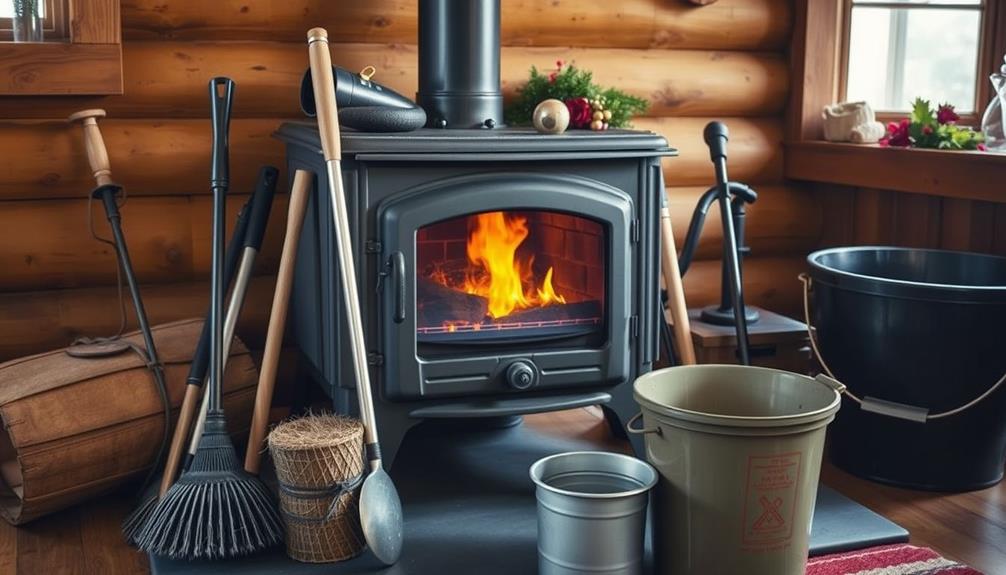
Annual wood stove maintenance is vital for your safety and the stove's efficiency. By performing yearly maintenance tasks, you can prevent issues like creosote buildup, which can lead to dangerous chimney fires.
Regular upkeep, similar to what you'd expect from a home cleaning service, guarantees that your wood stove operates safely and effectively. Here are three significant maintenance activities to include in your annual routine:
- Hire a certified chimney sweep: They'll inspect and clean your chimney for blockages, cracks, and creosote buildup, guaranteeing safe operation throughout the year.
- Inspect the flue pipe: Check for signs of wear or blockage. A clear flue pipe allows smoke to escape properly, enhancing your stove's efficiency and safety.
- Clean the vacuum fan: Keeping the vacuum fan clean guarantees peak performance and helps prevent noise or imbalance during operation.
Additionally, don't forget to check your smoke detectors. Replace batteries and test alarms to confirm they're functioning correctly.
Documenting all maintenance activities will help you track the stove's condition and performance over time, contributing to its longevity and safe operation.
Benefits of Regular Maintenance
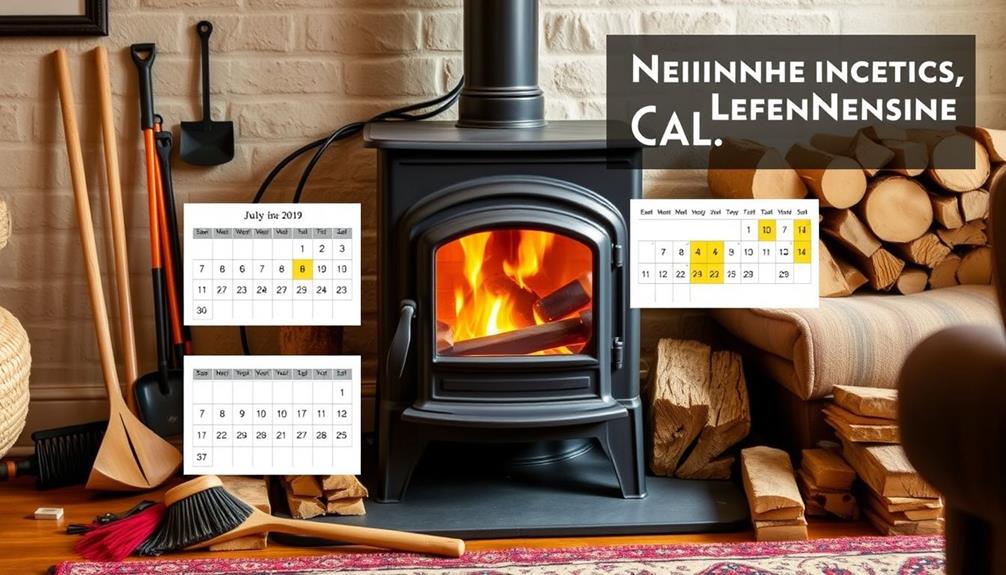
Regular maintenance of your wood stove greatly boosts safety, efficiency, and lifespan.
By keeping your stove in top condition, you reduce the risk of hazards while also improving how well it operates.
Additionally, maintaining good indoor air quality is essential, especially when using a wood stove, as it can contribute to pollutants in the air.
Using products like ozone air purifiers can help mitigate these issues.
Plus, a well-maintained stove can last you many years, saving you money in the long run.
Enhanced Safety Measures
A well-maintained wood stove not only provides warmth but also greatly enhances your home's safety. Regular maintenance considerably reduces the risk of chimney fires by addressing creosote buildup, which can ignite at temperatures as low as 451°F.
Additionally, utilizing proper cleaning tools can improve your stove's efficiency and longevity, making it vital to reflect on budget-friendly vacuum options for easy cleanup. By sticking to a maintenance schedule, you guarantee that your wood burning stove operates safely and efficiently.
Here are three key safety measures to reflect on:
- Regular Inspections: Perform weekly inspections to check for signs of creosote buildup and guarantee all components are functioning properly. This helps prevent chimney fires and dangerous carbon monoxide leaks.
- Professional Inspections: Schedule annual inspections with certified professionals. They can identify potential hazards and extend the lifespan of your stove, guaranteeing it remains safe for years.
- Detector Maintenance: Keep smoke detectors and carbon monoxide detectors in good working order. This early detection system is vital for your safety, alerting you to hazardous conditions before they escalate.
Improved Efficiency Levels
Your wood stove's efficiency can greatly improve with consistent maintenance, translating to better heat output and reduced fuel consumption. Regular maintenance can boost your stove's efficiency levels by up to 30%.
One of the most vital tasks is cleaning the chimney and stovepipe annually to prevent creosote buildup. This buildup can't only hinder efficiency but also pose a fire risk. Additionally, keeping your home safe from potential hazards is important, as ten household dangers identified for dogs can also apply to maintaining a well-kept environment.
Weekly removal of ashes is equally important; it guarantees that airflow isn't obstructed, allowing for peak combustion and better heating performance.
Additionally, monthly inspections and cleaning of the baffle and blanket help maintain even heat distribution, maximizing your stove's efficiency.
To further enhance your wood stove's performance, document your maintenance tasks and wood usage. Tracking these details enables you to identify trends, refine your heating strategy, and ultimately improve efficiency.
Extended Equipment Lifespan
Maintaining your wood stove isn't just about efficiency; it's also key to extending its lifespan. With regular maintenance, you can potentially extend your stove's life by up to 20 years, saving you considerable replacement costs.
By performing routine tasks, you not only guarantee optimum performance but also prevent costly repairs down the line. For instance, using a well-rated stove like the Englander 10-Cpm can enhance efficiency markedly, as it generates up to 50,000 BTUs while maintaining an impressive efficiency rating of approximately 85% high-efficiency rating.
Here are three essential maintenance activities to keep your wood stove in top shape:
- Monthly Inspections: Regularly check components like the baffle and chimney. Early detection of issues helps prevent costly repairs and keeps everything running smoothly.
- Annual Professional Inspections: Schedule yearly cleanings to guarantee the chimney's structural integrity and prevent hazardous creosote buildup, which can pose fire risks.
- Documenting Maintenance Activities: Keeping a record of your maintenance tasks allows you to track stove condition over time. This documentation can reveal patterns that indicate underlying issues, helping you address them before they escalate.
Safety Measures and Resources
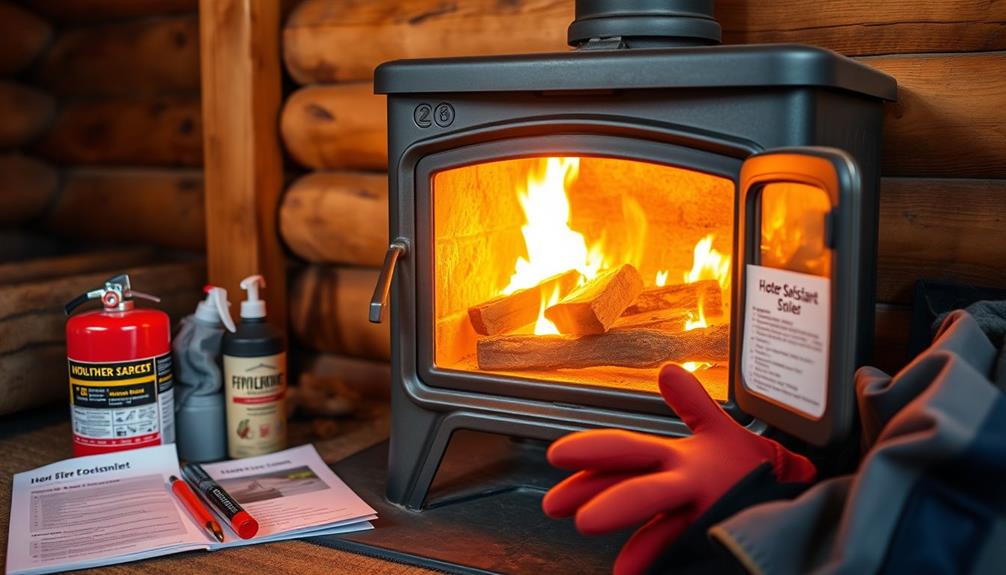
Guaranteeing safety around wood stoves is fundamental for every household. To protect your home, install smoke detectors on every level and test them monthly. Make it a habit to replace batteries at least once a year to maintain functionality.
Carbon monoxide detectors are also essential, especially in areas with combustion appliances. Just remember not to place them directly above your wood stove to avoid false alarms.
Additionally, understanding the importance of mental health support can help create a safer and more aware environment for all family members. Have multipurpose fire extinguishers nearby for quick access in case of an emergency.
Educating children about the dangers of high surface temperatures is essential; always supervise them near the stove to prevent accidents.
Scheduling annual inspections by qualified professionals is a key part of wood stove maintenance. These inspections can greatly reduce the risk of chimney fires and guarantee your stove operates efficiently.
Regular checks will help identify any potential hazards before they become serious issues.
Incorporating these safety measures won't only protect your family but also enhance the overall safety of your home. Stay proactive about fire safety, and you'll enjoy your wood stove with peace of mind.
Cleaning Procedures and Techniques
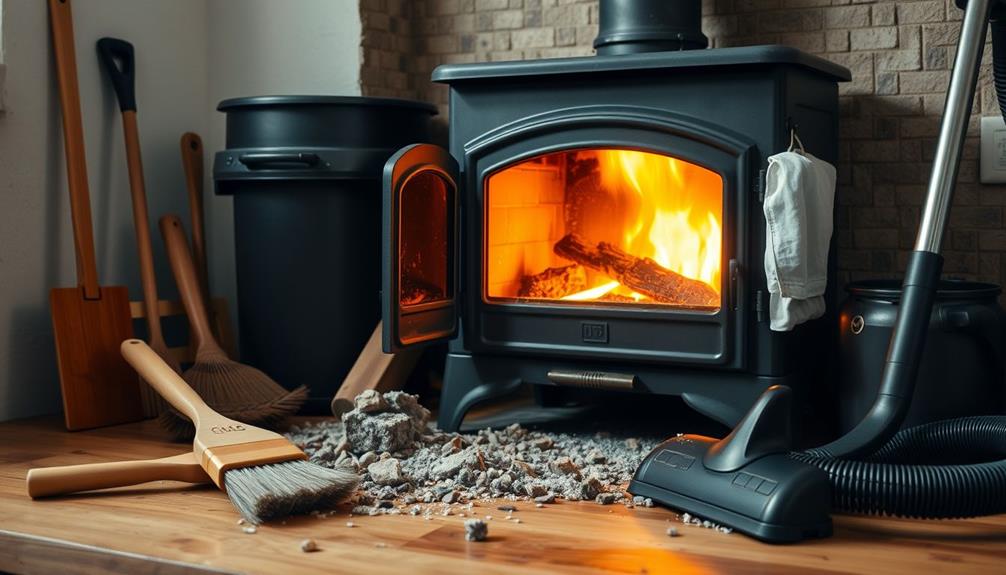
With safety measures in place, it's time to focus on keeping your wood stove clean for peak performance. Proper cleaning procedures not only enhance efficiency but also extend the life of your stove.
Start by gathering your supplies: brushes, buckets, vacuum, and safety gear like gloves, eyewear, and masks. Regular maintenance is vital for guaranteeing safety and efficiency; for instance, verify your chimney is free from obstructions to prevent smoke buildup and enhance airflow a well-draining soil essential for your plants.
Here's a straightforward cleaning routine:
- Remove Ash and Debris: Use a shovel to scoop out large ash and debris, then vacuum or sweep the remaining ash from the firebox and air tubes. This minimizes fire risks and maintains efficient airflow.
- Clean the Glass: Once the stove has cooled completely, use a specialized wood stove glass cleaner to remove soot and residue. This guarantees the glass stays clear, enhancing your view of the fire without scratches.
- Chimney Maintenance: Regularly clean the chimney flues by brushing from the top down to eliminate creosote deposits. Pay extra attention to horizontal sections where buildup tends to occur.
Frequently Asked Questions
What Yearly Maintenance Is Required on a Wood Stove?
You need to hire a certified chimney sweep yearly for inspection and cleaning. Clean the vacuum fan, check smoke detector batteries, inspect the flue pipe, and document all maintenance activities to guarantee your wood stove runs safely and efficiently.
How Do You Season a Wood Stove?
You'd think seasoning a wood stove means just lighting it up, but it's about preparing dry wood for efficient burning. Air-dry your wood for at least a year, ensuring it burns clean and hot.
How to Maintain a Wood Stove?
To maintain your wood stove, you should regularly clean out ashes, inspect components for wear, and check seals. Keeping a maintenance log helps track your stove's performance and guarantees safety for efficient heating.
How Often Does a Wood Stove Need to Be Cleaned?
You should clean your wood stove at least once a month during the heating season. After each use, remove ashes to guarantee proper airflow, and consider professional cleaning annually for maximum safety and efficiency.
Conclusion
In wrapping up, keeping your wood stove in tip-top shape isn't just a chore; it's a cozy ritual that enhances your home's warmth and safety. By embracing a regular maintenance schedule, you'll guarantee your stove runs smoothly and efficiently, turning chilly days into inviting evenings. So, take a moment to savor the simple pleasures of this upkeep, and you'll be rewarded with peace of mind and a toasty haven for you and your loved ones.

